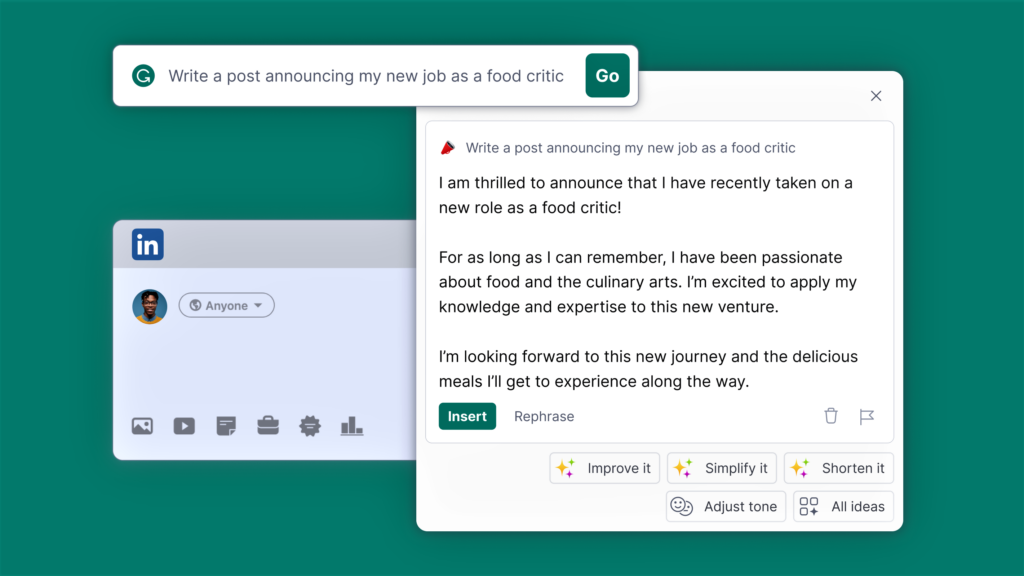Grammarly goes big with generative AI features in GrammarlyGO

|
Getting your Trinity Audio player ready...
|
Generative AI wowed us first with images produced using art-generating tools such as OpenAI’s DALL-E models, Midjourney’s Discord Bot, and various implementations of StabilityAI’s Stable Diffusion text-to-image algorithm. Then came ChatGPT, an incredibly versatile advanced chatbot powered by GPT-3, a large language model developed by OpenAI and hosted on Microsoft Azure. Signups for the various products have skyrocketed, with ChatGPT setting records for the fasted growing user base (ahead of TikTok and Instagram). In fact, its enduring popularity can cause ChatGPT’s servers to max out at the busiest times of the day, disappointing users of the free research preview with a “ChatGPT is at capacity right now – get notified when we’re back” message. Generative AI has caught on big time with users – for example, clicking on an invite from Midjourney to use Discord reveals that 1,170,214 accounts are currently online, and the art-generating service has 13,329,066 members in total. And it’s not just the growth in adoption that’s been impressive, the speed at which services have been integrated into a wide range of products, from Microsoft’s Bing search to Shutterstock’s image library has been rapid too. Plus, that list of apps now includes GrammarlyGO – the latest version of Grammarly’s online writing tool, newly equipped with various generative AI features.

Composition capability: Grammarly has introduced generative AI features to the latest version of its communications tool dubbed GrammarlyGO. Image credit: Grammarly.
According to the firm, which began in 2009 by launching a subscription product to help students correct their spelling and grammar, GrammarlyGO will roll out in beta in phases to Grammarly’s 30 million daily users. “The GrammarlyGO icon will appear alongside individuals’ text where they’re using Grammarly, and they can choose to interact with its features by simply clicking it,” Grammarly’s development team told TechHQ. “They can also toggle access to GrammarlyGO on or off in their settings.”
What are the new features of GrammarlyGO?
The fact that we are writing about Grammarly’s launch of GrammarlyGO in March 2023 – a few months on from the initial surge of excitement in generative AI – hints that the firm has resisted the urge to race its roll out generative AI features. Certainly, looking through the list of upgrades, Grammarly has been careful to build on the core features of its popular online spelling- and grammar-checking tool and ensure that generative AI delivers on the company’s promise to ‘elevate your writing’.
GrammarlyGO enables users to compose sections of text via a prompt – an option that’ll be familiar to anyone who’s asked ChatGPT for writing assistance. Also, the tool is able to understand the context of emails and offer quick prompts that can then be fed into the generative AI backend to suggest a longer reply. Entire sections of text can, according to Grammarly, now be automatically rewritten for tone and clarity – for example, users could submit requests for the text to appear friendlier or sound more professional. Also, sections that are overly long can be trimmed to length thanks to summarizing functionality that can be prompted too. If writers are struggling for ideas, GrammarlyGO has the capacity to provide outlines that can be built up into a full article, helping those suffering from writer’s block or blank page syndrome. And the tool will also generate prompts as you type, which give users the option of jumping ahead with their writing. Finally, there’s the possibility to personalize your voice, which could help to pull together articles with multiple authors into something that sounds more coherent and has a unified tone.
Many of these generative AI features will sound familiar if you already use writing composition tools such as Jasper.ai, Lavendar, or others, but often they involve jumping back and forth between the app and the document you’re working on, which isn’t an ideal workflow. But, based on the developer comments, GrammarlyGO will let you apply its features within the various productivity tools that you have open, providing writing support in email clients, word processers, web browsers, and the list goes on.
And thinking further ahead, there are some clues to what could be next in recent comments made by Rahul Roy-Chowdhury – Grammarly’s Global Head of Product. Roy-Chowdhury joined the spelling- and grammar-checking firm in May 2022, having spent 14 years at Google, where he was Vice President of Product Management – a role that included leading privacy, safety, and security teams. It’s clear that Grammarly has a vision of augmented intelligence, helping rather than replacing writers. And given that it is writers who pay Grammarly’s bills, not chatbots – it feels like a sensible business decision.
Next steps for Grammarly
Rahul Roy-Chowdhury breaks out the writing process into a series of steps, starting with the conception stage, followed by composition and revision, and – for the reader – comprehension. “To date, we’ve been focused on the revision stage of the communication lifecycle,” he writes in a recent blog post on Grammarly’s website. “By embracing new technologies like generative AI, we can advance our vision of supporting the entire process—from conception to comprehension.”










